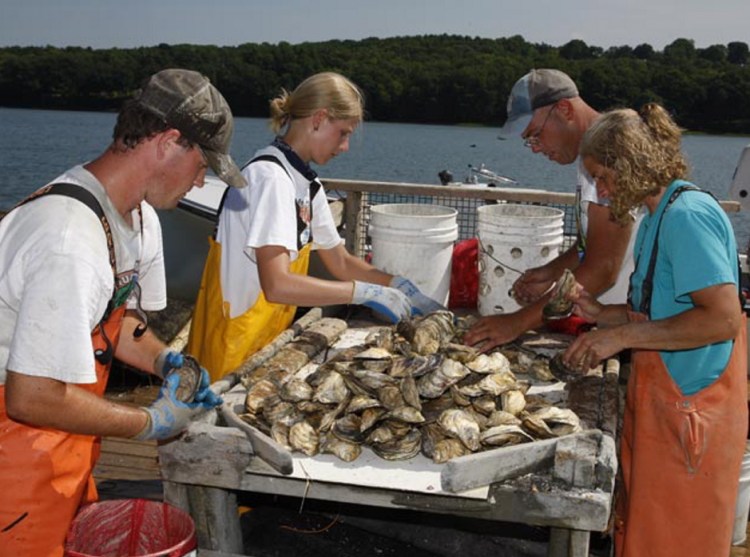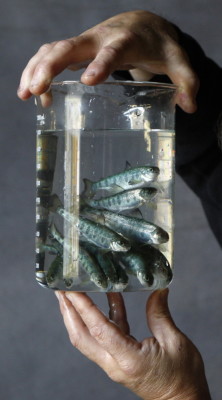Maine’s growing aquaculture industry has matured to the point where fish farms are finding it easier to get loans from commercial lenders and are attracting capital from private equity investors, according to industry leaders and financial experts.
Maine’s clean, productive marine environment and the state’s reputation for producing quality food products has created a “perfect match” for investors looking for sustainable ways to meet the surging global demand for food, said John Pavan, owner of Altezza Advisors, a Brunswick-based firm that has invested in three Maine aquaculture companies.
“There is a lot of growing momentum in this space in Maine,” said Pavan, one of the nearly 100 investors, researchers and industry officials attending Maine’s first aquaculture forum devoted to research and development Wednesday.
The forum, held in Portland at the Holiday Inn by the Bay, will be followed Thursday and Friday by the larger Northeast Aquaculture Conference & Exposition at the same location. It will be attended by about 450 people from as far away as Virginia and the Canadian provinces of New Brunswick, Nova Scotia and Prince Edward Island.
John Bullard, northeast regional administrator for the National Marine Fisheries Service, will speak Friday. The National Oceanic and Atmospheric Administration is one of the forum’s leading sponsors.
That Maine was selected to host the biennial meeting reflects the state’s position as an industry leader. It has been the top aquaculture state nationally since 2011 in terms of sales, according to Sebastian Belle, executive director of the Maine Aquaculture Association. Farmers here sell $50 to $100 million in aquaculture products annually, he said. Production varies widely from year to year.
Nationally, aquaculture has experienced flat growth in recent years, while Maine production volumes have increased an average of 8 percent annually over the past decade, he said. Ninety companies in Maine now operate 180 aquaculture farms and employ about 600 people.
Salmon is by far the top farmed species in Maine, followed by oysters and mussels.
The industry in Maine benefits from having a well-managed regulatory system seen as fair and predictable, said Dick Clime, a former oyster farmer who now works on waterfront development projects for CEI, a Maine-based community development corporation that provides financing to small and medium-sized businesses.
The industry is relatively new. It began in 1973 when the Maine Legislature passed a law that governs the leasing of public marine waters by private interests.
Clime said the commercial lenders are now more comfortable about lending money to aquaculture ventures, and private equity investors are showing greater interest.
“That is the fuel that will grow the industry,” he said.
Belle, the aquaculture association’s director, said Maine’s research facilities, such as the Darling Marine Center in Walpole and the University of Maine’s Center for Cooperative Aquaculture Research in Franklin, are the best in North America, but the state faces a serious shortage of “intellectual capital” because few researchers specialize in aquaculture. The university 20 years ago had 10 to 12 researchers involved in aquaculture, but it now has only two or three, he said.
But there will be more opportunity for research projects in the near future, thanks to a $20 million grant from the National Science Foundation, said Paul Anderson, director of the Aquaculture Research Institute, one of the sponsors of Wednesday’s forum.
The grant, to be spent over five years, will be used to transform the state’s 3,500-mile coastline into a “living laboratory” to study social and environmental interactions among aquaculture and coastal ecosystems. Other institutions, including the University of New England and the Bigelow Laboratory for Ocean Sciences, are also involved.
Greg Lambert, the fresh water production manager at the Cooke Aquaculture hatchery in Bingham, which raises salmon, said his sector could benefit if researchers could find more efficient ways to remove sea lice from the fish. In addition, researchers might find non-lethal ways to keep seals from getting into pens and eating salmon.
He said the industry also needs to find a way to breed salmon so they can endure the sub-freezing water temperatures that sometimes occur in winter in the shallow waters off the coast of Maine. Larger salmon die under such conditions because their blood freezes, he said. In the natural environment, salmon can escape the cold by swimming to deeper water where it’s warmer.
He said Maine has a huge advantage over other states that have salmon farms, such as Washington.
“We have the working waterfront, he said. “We have people who want to do that kind of work.”
Send questions/comments to the editors.




Comments are no longer available on this story